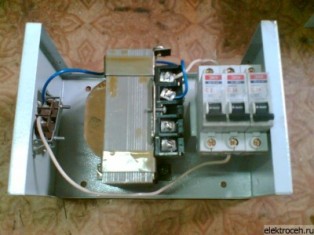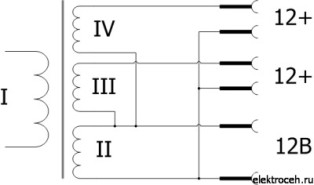Categories: Practical Electronics, Electrician Secrets
Number of views: 65761
Comments on the article: 1
Home-made step-down transformer for damp rooms
In damp rooms, garage boxes in the "pit", and other safety rooms, it is required to install lamps with 12 Volt lamps. To power such lamps, a step-down transformer is used.
In addition to conventional transformers, recently appeared on sale electronic pulse transformers. However, when used to power the luminaires, a voltage of 12 volts with a long wire length of the lamp starts to burn dimly, at full heat. Let's try to solve this problem.
Recall physics. The power of an incandescent lamp is 60 watts, the voltage from the transformer is 12 volts, from here we calculate the current: 60/12 = 5 amperes. If a current of 5 Amperes flows through 220 Volts, then the power will be 1.1 kW. With a large current, a voltage drop occurs, the voltage drop depends on the length of the wire and its cross section. A voltage drop of 5-6 volts at a voltage of 220 volts is not so noticeable, but at 12 volts this is half the voltage.
I see three solutions to this problem. Firstly, to use light bulbs of lower power. Secondly, increase the cross section of the wire and reduce its length. Third, increase the supply voltage.
The first solution is obvious, if all the same the 60 W bulb shines in full light, maybe you should use a 40 W bulb and it will shine brighter. Well, if you find or make your own LED lamp, then it will be even better.

When powering the lamps from a step-down transformer, the wire must be taken with a copper section of at least 2.5 mm2, and preferably 4 mm2 or even 6 mm2. An aluminum wire should not be used, since aluminum has a higher resistivity than copper and the voltage drop will be much larger.
Well, the most radical way is to increase the voltage from the transformer. This method will help anyway. Please note that it is necessary to increase the voltage for each wire coming from the transformer individually, because if you select a voltage on a long wire, for example, 18 Volts and the bulb lights up normally, then it will burn out on a short wire.
For a conventional transformer, we take the wire the same as its secondary winding and wrap it over the transformer winding. We select the number of turns, as mentioned above, depending on the wire going from the transformer to the bulb.
We do it this way, measure out a piece of wire of two meters, connect one end of it to one terminal of the transformer, wrap several turns with the other and connect it to the wire that goes to the light bulb, the free terminal of the transformer also connects to the other wire of the light bulb.

We turn on the transformer in the network and see how the light is on. If the light bulb burns dimmer than before, then we connect the end of the wire that we used connected to the secondary winding of the transformer to its other terminal, and also switch the wire going to the light bulb. We turn on the transformer again, we look at how the bulb is lit, if there is not enough brightness, we press a few more turns, and so on, until the bulb burns normally. After that, we assemble the transformer thoroughly and use it.
Read also on this topic:Isolation transformer in a home electrician workshop
See also at e.imadeself.com
:
